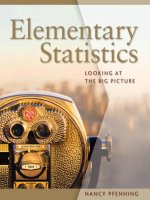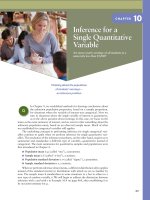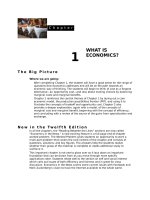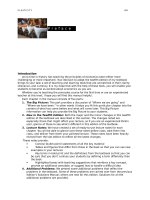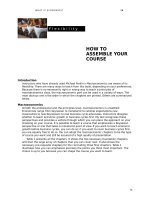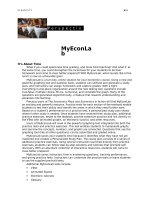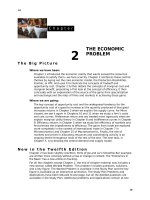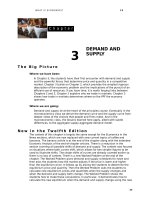The big picture marcoeconomics 12e parkin chapter 1 preface
Bạn đang xem bản rút gọn của tài liệu. Xem và tải ngay bản đầy đủ của tài liệu tại đây (95.1 KB, 2 trang )
ELASTICITY
III
P r e f a c e
Introduction
At no time in history has teaching the principles of economics been either more
challenging or more important. Your decision to adopt the twelfth edition of my textbook
brings to your task a set of teaching and learning tools that are unmatched in their clarity,
relevance, and currency. It is my hope that with the help of these tools, you will enable your
students to become as excited about economics as you are.
Whether you’re teaching the principles course for the first time or are an experienced
teacher at this level, I hope you will find this manual helpful.
Each chapter in the manual consists of five parts:
1. The Big Picture: This part provides a discussion of “Where we are going” and
“Where we have been.” In other words it helps you fit this particular chapter into the
context of what has come before and what will come later. This Big Picture
information can help you provide the Big Picture to your students.
2. New in the Twelfth Edition: Both the major and the minor changes in this twelfth
edition of the textbook are described in this section. The changes noted are
especially those that might affect your lecture, so if you are an experienced Parkin
user, glance at these to see what’s different in this edition of the textbook.
3. Lecture Notes: We have created a set of ready-to-use lecture notes for each
chapter. You will be able to glance over these notes before class, take them into
class, and deliver from them your polished lecture. These notes have been heavily
revised from the last edition to reflect all the latest changes.
These notes provide:
Concise (bullet point) statements of all the key material
Tables and figures that differ from those in the book so that you can use new
examples in your lectures
Key terms in bold print and the definitions from the textbook so that you can
be sure that you don’t confuse your students by defining a term differently than
the book
Highlighted boxes with teaching suggestions that reinforce a key concept,
provide an additional anecdote, or suggest how to handle a difficult idea
4. Additional Problems: We present some additional problems that reflect the
problems in the textbook. Some of these problems are carried over from the previous
edition’s Solutions Manual; others are new for this edition. Solutions for all the
additional problems are provided.
IV
5. Additional Discussion Questions: Additional discussion questions have been
created for each chapter. Some of these questions are suitable for essay exams;
others, more open-ended, are probably best used for classroom discussion. All of
them are designed to make your students think and use the material you have been
teaching them.
Do not forget that the answers and solutions to all the Review Quizzes and the Problems
at the end of each chapter are provided in a separate book, the Solutions Manual. The
Solutions Manual has both the questions from the textbook and complete answers all in one
handy source. You can use these answers and solutions to help you grade problems you
have assigned to the students or else you can copy them and hand them out directly to the
students.
The Electronic Classroom
The next Perspective features a special essay designed to assist your teaching in
another way by discussing MyEconLab, an incredibly powerful Internet site that is a source
of “one-stop shopping” for both your students and you. This essay can help you see all that
is available to you—and your students!—on MyEconLab.
Acknowledgments
Teaching the principles of economics is a “work in progress.” As new insights are
uncovered, as new knowledge emerges, the principles of economics course changes and
evolves. So, too, are Parkin’s Microeconomics and Macroeconomics always changing and
evolving to remain the best books available for you and your students’ use. Thus, it is with
a great deal of pleasure that we acknowledge and thank several people who have helped us
in shaping this edition of the Instructor’s Manual.
Mark Rush of the University of Florida edited (slightly!) the very fine work of Laura Wolff
of Southern Illinois University Edwardsville and Russ McCullough of Ottawa University, who
adapted previous work and wrote the new material for this, the twelfth edition of this
instructor’s manual for Parkin’s Macroeconomics. Andra Skaalrud at Pearson played a
crucial role in coordinating and producing this manual.
Even with all this help, there remains room for improvement in the text and (says Mark)
in this manual. Any corrections, suggestions, or comments that you have will be greatly
appreciated. Send your comments on this manual to Mark () and
your comments on the text to me ().
Michael Parkin
University of Western Ontario

